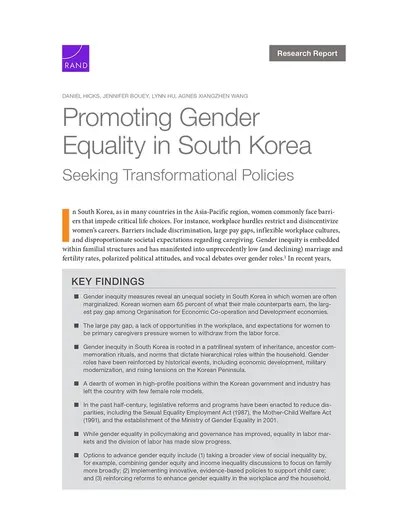Promoting Gender Equality in South Korea
Daniel Hicks, Jennifer Bouey, Lynn Hu, Agnes Xiangzhen Wang

In this report, the authors analyze the social, cultural, and political drivers for existing gender inequality and explore the best models for social change to improve gender equity in South Korea. In South Korea, and in most countries in the Asia-Pacific region, significant pay gaps, inflexible workplace cultures, and social expectations of women to be the primary caregivers for children and households pressure women to withdraw from the labor force. Most women's work at home is also not considered as contributing to the economy. These gender inequalities are often part of a larger pattern across society, despite the implementation of policies and laws to promote gender equity. Overcoming such barriers to achieving equality requires transformational approaches to changing the political, legal, and social environments.
The authors present a topic-specific narrative literature review on South Korea's gender equity status, the historical-cultural influence on gender equity, and policy changes in the past 50 years. The report focuses on two specific themes: (1) gender equity in well-being, marriage, and fertility and (2) gender equity in the household and labor market. The authors incorporate brief discussions of the papers presented at a November 2022 gender equity conference throughout these themes, with the full papers included in a separate annex. Finally, they provide an update on the latest South Korean policy priorities and a set of recommendations for improving gender equality in South Korea.
Key Findings
-
Gender inequity measures reveal an unequal society in South Korea in which women are often marginalized. Korean women earn 65 percent of what their male counterparts earn, the largest pay gap among Organisation for Economic Co-operation and Development economies.
-
The large pay gap, a lack of opportunities in the workplace, and expectations for women to be primary caregivers pressure women to withdraw from the labor force.
-
Gender inequity in South Korea is rooted in a patrilineal system of inheritance, ancestor commemoration rituals, and norms that dictate hierarchical roles within the household. Gender roles have been reinforced by historical events, including economic development, military modernization, and rising tensions on the Korean Peninsula.
-
A dearth of women in high-profile positions within the Korean government and industry has left the country with few female role models.
-
In the past half-century, legislative reforms and programs have been enacted to reduce disparities, including the Sexual Equality Employment Act (1987), the Mother-Child Welfare Act (1991), and the establishment of the Ministry of Gender Equality in 2001.
-
While gender equality in policymaking and governance has improved, equality in labor markets and the division of labor has made slow progress.
-
Options to advance gender equity include (1) taking a broader view of social inequality by, for example, combining gender equity and income inequality discussions to focus on family more broadly; (2) implementing innovative, evidence-based policies to support child care; and (3) reinforcing reforms to enhance gender equality in the workplace and the household.
Recommendations
-
Policymakers should take a broader view of social inequality when working to combat gender inequity. Policy efforts aimed at reducing forms of social and income inequality may prove more politically feasible and may improve gender equality by aligning the goals of broader groups of the population.
-
Policymakers should implement innovative, evidence-based government policies to help families with child care and reduce education stress.
-
Policymakers should reinforce reforms to enhance gender equality in the workplace and the household. Workplace and household gender ideologies often remain directly untouched in policymaking. Future policymaking should address gendered cultural norms and ideologies in both spheres, whether directly or indirectly.
Sourced from https://www.rand.org/pubs/research_reports/RRA2547-1.html
RAND Corporation
